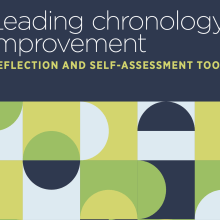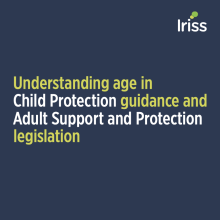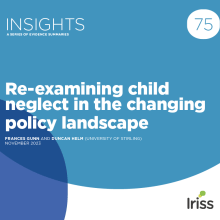Key points
- Parents who attend Initial1 Child Protection Case Conferences (CPCCs)2 report largely negative experiences which leave them distressed and disempowered.
- Practitioners want to involve parents but are hindered by processes which arise from the neoliberal social policies that have changed social work practice in recent decades.
- There is discord between government guidance, which promotes parental participation at CPCCs, and the reality of practice.
- While there are clear requirements for CPCCs, improvements to how they are conducted is needed. Other decision-making approaches such as Family Group Decision Making (FGDM) should be promoted.
Introduction
Not long after I began my career as a social worker, I completed my thesis on this topic. My interest stemmed from being privy to a significant number of CPCCs as a minute taker; the silent observer within the CPCC, and then as a practitioner hearing directly from parents. Before carrying out research, I wondered if my observations of minimal parental participation at CPCCs were purely anecdotal. Unfortunately, the evidence base speaks to the ongoing lack of parental participation in CPCCs and highlights the negative impact of rigid child protection processes on parents and practitioners alike. Research indicates that CPCCs do not promote participation and they are experienced by parents as restrictive and distressing (Diaz and colleagues, 2017; Jackson and colleagues, 2016; Buckley and colleagues, 2010; Jackson and colleagues, 2020; Dale, 2004).
While it is problematic that there has been no significant improvement to the way parent/s experience CPCCs over the decades, it is heartening to see that new policies highlighted in this evidence summary acknowledge the need for reform. Child protection casework does not occur in a vacuum, so this Insight refers to the socio-political context in which casework occurs, to highlight how structural factors have, and continue to impact, on the ideals of participation. The views of some of the practitioners interviewed are interspersed throughout.
Child Protection Case Conferences: an overview
The National Child Protection Guidelines (NCPG) were updated in 2021 when this Insight was being written. I refer to both versions as the new guidance is not fully embedded into practice. The updated guidance reflects changes within child protection and appears to acknowledge flaws with the system, which were highlighted by the Independent Care Review (2020). This seminal review advised that widespread reform of the ‘care system’ was required; its findings resulted in The Promise (2020).
When a child protection referral is shared with police, health services, or social work, an interagency referral discussion (IRD) can be called. Following an IRD, one of the routes which can be pursued is the CPCC. CPCCs are generally chaired by senior social work professionals. The main decision to be made at an initial or pre-birth conference is whether the child’s name is placed on the Child Protection Register (CPR), a central register of children subject to a multi-agency child protection plan (NCPG, 2014). Registration means professionals have agreed that the child is at risk of significant harm. The meeting is a forum for discussion between different agencies. In Scotland, a CPCC is attended by key professionals and family members; parent or child attendance is not obligatory.
CPCCs are not legal forums, however, local authorities are legally obliged to ‘have regard to the guidance issued under section 96 (3) of the 2014 Act’, which refers to the duty to assess the child’s wellbeing. Many of the central tenets of the NCPG (Hill, 2016) promote professional transparency and parental involvement. Yet, there remains a lack of clarity about parental involvement within a CPCC. However, it is positive to see that the updated NCPG notes the importance of the chairperson’s role to seek the views of parents.
CPCCs during a pandemic
The COVID-19 pandemic cannot go unacknowledged given the impact it has had on practice. The alterations to processes by all local authorities are likely to remain for the foreseeable future. CPCCs are continuing to take place over online platforms or via teleconferences. While Scottish Government statistics note an increase in child protection referrals over the pandemic, there was no increase in the number of children placed on the CPR (2021). In England, some practitioners noted that despite the lack of in-person contact, restrictions allowed for more caring, humane practice, with less focus on control and less bureaucratic processes (Ferguson and colleagues, 2021).
There is no current Scottish research on how the pandemic impacted parents’ participation at CPCCs, although the findings of a recent English study are noteworthy. This study found that while several hundred professionals spoke positively about virtual meetings, a much smaller sample of parents stated that they would prefer face-to-face meetings (Roe and colleagues, 2020). Given the inherently challenging nature of CPCCs, it is unsurprising that virtual CPCCs proved difficult for some parents. However, in a study by Jackson and colleagues (2020), parents also noted the emotional impact of numerous professionals at CPCCs, so it may be that some parents found teleconferences less challenging than in-person meetings.
Practitioners worldwide have raised concerns about the ethics and practical difficulties of working remotely with families (Banks and colleagues, 2020). There are often technical issues and concerns about privacy when virtual meetings are held. Furthermore, we know that communication within social work is complex and that telephone/video communication can hinder effective communication. Information can easily be misinterpreted when not delivered in person (Lishman 2009; Trevithick, 2012). It may be that a balance can be struck between in-person and virtual meetings which prioritises individual needs.
Child protection casework and CPCCs
The Children (Scotland) Act 1995 enshrined the rights of parent/s and children to participate in decision-making processes to an extent. The Children and Young People (Scotland) Act 2014) highlighted children’s rights and showed the progress made since 1995. The introduction of Getting it Right for Every Child (GIRFEC) also remains the ‘bedrock’ of children’s services (The Scottish Government, 2012).
More recently, the Scottish Government has committed to widespread reform of the care system in The Promise (2020). There has also been an increased focus and funding for ‘trauma-informed practice’ (TIP) across the public sector – the evidence base highlights TIP’s positive impact on service users. While recognising and responding to trauma is by no means new to social workers, widespread TIP will likely be of particular benefit in child protection casework.
UK-wide governmental child protection guidance reflects certain participatory discourses (Jackson and colleagues, 2016), and the participation agenda within public services is at the forefront of policy. However, there is a distinct lack of research into the viability of parental participation at CPCCs. While child protection work has been widely researched since the 1970s – and there is extensive literature on the subject (Ferguson, 2011; Beckett; 2007; Parton, 2014) – research that speaks to parents’ experiences remains limited.
In the 1990s and early 2000s, when parental attendance at CPCCs was new, research findings were mixed. Some parents reported a somewhat participatory experience, and others reported limited involvement and feelings of powerlessness (Hall and Slembrouck, 2001; Hayes, 1997; Bell, 1996). A study by Macaskill and Ashworth (1995) found that social workers were positive and open to parent participation at conferences. Current research does not suggest this has changed, however, the socio-political context has dramatically changed since CPCCs were established.
Engaging with and involving service users is a longstanding part of good practice that is embedded in relationship-based social work. The significance of the relationship between professional and client/s is key to positive engagement with families (Turney, 2012; Jackson and colleagues, 2016). Yet, the translation of participatory ideals – alluded to in theory and policy – into child protection work is intrinsically challenging (Corby and colleagues,1996). It is questionable whether the guidance, which states that parents should be involved in child protection planning and decision making (Scottish Government, 2020), recognises these complexities. Social workers are required to manage ‘conflicting organisational dictates’ (Healy and Darlington, 2009, p422) due to the numerous statuses the parent/s occupy. Indeed, Gallagher and colleagues (2012) highlight that participation is far more nuanced than policies promoting it might suggest. In relation to the ‘participatory paradigm’, Jackson and colleagues (2020) highlight that this ‘invokes a reductionist conceptualisation of participation which is not fit for purpose.’ (p5).
“The control function […] sits at the fore … I think that that puts up a huge barrier to people participating and engaging in child protection […] if we were to intervene at lower levels, you could start to build up supportive relationships with people.” (Oliver, 2018)
As highlighted, the socio-political context in which child protection work occurs must be acknowledged. While Scottish guidelines differ slightly from other parts of the UK, the neoliberal political context and its link to the aforenoted ‘participatory paradigm’ is evident. The 2010 coalition government significantly contributed to ‘neoliberal paternalism’, a shift from the ‘nanny state’ to the ‘muscular state’ (Parton, 2014, p140). While highlighting that neoliberalism promoted a relaxed approach to economic matters, Parton noted that it took the opposite approach to poor, marginalised individuals, which was reflected in ‘austerity’ policies: cuts to benefits and significant cuts to local authority budgets (Lavalette, 2017). This muscular authoritarianism is linked to an excessive preoccupation with managing actual or perceived risks that do not consider the complexities of risk (Webb, 2006) and subsequently do not promote parental involvement.
The well-documented effects of neoliberal policies on social work include managerialism, standardisation, micro-management, rigid processes, and de-professionalisation (Featherstone and colleagues, 2014). Practitioners report that this can negatively impact the relationship they are trying to build/ already have with families (Smith and colleagues, 2012), and has implications on attempts to foster participation. Timescales for assessments and an increase in social work's ‘policing’ element exemplify managerialism taking precedence over responding to family needs (Rogowski, 2012). The technocratic, jargonistic and target driven language used within policy and CPCCs reflects this marketised approach (Broadhurst and colleagues, 2011).
“Primarily everything is done at a management level, a higher level … like the whole IRD process and decision-making process […] I think we could do it at a much lower level.” (Oliver, 2018)
Parent experiences
Two separate studies by Jackson and colleagues (2016, 2020) in one local authority provided insight into the experiences of Scottish parents. Their feedback echoed previous studies within and outwith Scotland. CPCCs were recalled with ‘sadness, confusion, dismay, bewilderment, shame and most notably anger’ (2020, p10). Parents reported feeling that the meeting centred on their ‘failings’ and that they had difficulties expressing their views and responding to others’ views. Some felt they were being ‘talked about’ by professionals (Jackson and colleagues, 2020, p10).
English studies (Smithson and Gibson, 2016; Diaz and colleagues, 2017) noted that parents often felt unprepared for conferences and reported feeling silenced and belittled due to power differentials. Smithson and Gibson spoke to concerns about ‘authoritarian’ methods.
“The decision is already made before a parent walks in so for them it's ‘what’s the point cause you’ve made your mind up’ and most of the time we have.” (Oliver, 2018)
Other recurring themes in the research (Oliver, 2018) included parents’ reference to the intimidating nature of the ‘quasi-legal’ (Hall and Slembrouck, 2001) style of CPCCs. The set-up of the room where CPCCs took place was also experienced as intimidating.
“The meeting rooms are just alien … we need to get much more family friendly.” (Oliver, 2018)
Professional use of language during CPCCs was noted as confusing and upsetting by parents in numerous studies. The use of language in specific contexts further establishes or reinforces power relations. If we contest that language is power, the term ‘Child Protection Case Conference’ is reflective of control being exercised through discourse (Fook, 2012). The unequal power relations present within child protection processes are undoubtedly exacerbated by the use of language (Dale, 2004; Jackson and colleagues, 2016). It is encouraging that the updated NCPG has noted a preference for a Child Protection Planning Meeting instead of a CPCC and acknowledged the importance of ‘non-stigmatising’ (2021, p111) language. The guidance now highlights the importance of recognising and responding to voices that were previously unheard.
Parents reported that they felt more able to participate when prepared for CPCCs. This indicates that further thought should be given to increasing timescales when practitioners consistently feel hindered by high caseloads and strict timescales. Furthermore, in a study by Buckley and colleagues (2010), it was noted that time to discuss the CPCC after it happened was beneficial.
Practitioner views
The interspersed views in this Insight reflect the perspectives of seven practitioners from one local authority. While they represent the views of a very small sample, some of Oliver’s (2018) findings correlated with the results of larger studies. For example, all practitioners in Oliver’s (2018) study supported parents’ attendance and participation (as they understood the term) at CPCCs, which was previously shown by Rose and colleagues (2014) and Corby and colleagues (1996). However, practitioners were not naïve to the difficulties of fostering participation in practice. There was no shared understanding of what participation meant in the context of the CPCC. Like the parent feedback previously referred to, the sample had ideas about how to practically improve CPCCs. Some practitioner views correlated with the evidence base – it was noted that the language of ‘child protection’ provoked fear in parents. Several practitioners also referred to the chairperson's responsibility in facilitating and promoting parental participation (Oliver, 2018).
The main findings in relation to participation:
- Practitioners felt the ‘control function’ in casework was a barrier to participation
- There was not enough time to carry out tasks such as preparing parents for CPCC
- The interviewees’ understanding of participation within the CPCC was limited to the bottom rungs of participation
- Value was placed on parents making verbal contributions, with parents described as ‘non-engaging’ if they did not share views
Improving CPCCs
A significant aspect of parent participation is involvement in decision making. There are substantial barriers to the realisation of this in a CPCC. As highlighted by Healy over two decades ago, ‘participation standards and ideals have been grafted onto child protection practice without […] consideration to the specific demands associated with such work’ (1998, p905). Child protection policy needs to recognise and reflect this disconnect, or there will be continued discord between the political narrative and frontline work. The Promise is undoubtedly a positive step forward, but it is too early to review its impact. The government must be held accountable for the pledges made within The Promise so that it is not a document with noble intentions that will not become a reality. It is encouraging that the over-representation of children growing up in poverty who are on the CPR is recognised in The Promise (2020). This serves as a reminder of the importance of recognising that many families’ problems are inextricably linked to structural elements often outwith their control.
Family Group Decision Making (FGDM)
Those practitioners who adopt a ‘family minded’ approach are often able to recognise the crucial role of family and community where intervention may be necessary. This type of reflective, thoughtful practice can foster parent participation. Family Group Decision Making (FGDM), also referred to as Family Group Conferencing, is an example of taking a family-minded approach. FGDM was introduced in the 1990s and originated in New Zealand. It is now undertaken throughout the UK and globally, and although not exempt from criticism, its success is well documented. FGDM takes a strengths-based approach where families and broader networks are asked to come together when decisions need to be made. Scottish legislation promotes FGDM alongside other models such as the Strengthening Families (SF) approach, which is used in many English local authorities. One study found that the SF approach contributed to parent/s feeling more engaged in CPCCs (Appleton and colleagues, 2015).
FGDM can offer an alternative approach when there are concerns about a child. It is not a replacement for a CPCC, which has a clear remit – an FGDM could be arranged before a CPCC/ or as part of the early intervention work that the Scottish Government promotes. Indeed, the NCPG (2021) highlighted the need for more holistic approaches to support families. FGDM recognises the role of using strengths within the family and community (Featherstone and colleagues, 2014) and, as such, is not generally experienced by parents as authoritarian.
In a briefing paper on the impact of FGDM, Mitchell and colleagues (2018) highlight that, as well as lessening the power imbalance between statutory services and families, FGDM can improve decision-making within child protection and improve long-term outcomes for families. The paper reports on research carried out across five local authority areas, and several councils reported fewer child protection registrations since FGDM was introduced.
What works for parents and practitioners
Jackson and colleagues' study (2020) elicited important feedback from parents, which led the local authority in question to make small but significant changes to their CPCCs. For example, adjustments were made to the rooms; parents were asked to respond individually to professional comments; and were invited into the room before professionals entered. Hall and Slembrouck’s (2001) study also noted that changing the order in which people contributed at CPCCs could be particularly beneficial as it could encourage a ‘reversal in pragmatic roles’ (p159). These changes could easily be applied across Scotland; however, they would only be suitable for face-to-face meetings.
When parents whose children are subject to child protection processes are asked what would help in these challenging situations, they generally refer to some of the basic tenets of ethical social work. They want to be treated with dignity and in a humane way, and to be listened to and treated with empathy. The importance of a trusting relationship between parent/s and practitioner, built over time, is consistently valued by both parents and practitioners (Smith and colleagues, 2012). The issues raised by parents cannot be resolved solely by practitioners on the frontline. However, it should be noted that for families to receive the best support, local authorities need to be proactive in their response to research that highlights a ‘frustrated, anxious and overwhelmed workforce’ (2020, p96).
Both parents and practitioners also valued the importance of clear communication and ready sharing of information, which shows transparent practice. Written reports (often long and comprehensive) should be shared in advance of meetings. While this does not deny the challenges of reading such reports (Smith and colleagues, 2012), it highlights that sensitive verbal information sharing with parents is essential. Given that many parents reported feeling confused and overwhelmed by professional input at CPCCs, professionals must be mindful of ways to lessen these feelings, and carefully consider how they share information before and during the CPCC. Practitioners should recognise that parents who are too fearful of contributing to meetings are not necessarily displaying ‘non-engagement’.
The need for better advocacy services for children and parents is highlighted in The Promise. Referring parents and children to advocacy services demonstrates good practice, and there is evidence, albeit small scale studies, to suggest advocacy can help facilitate parental engagement (Featherstone and Fraser, 2012). Peer-to-peer advocacy has also been noted to benefit parents, however, there is a distinct lack of parent-led initiatives in the UK. Parents Advocacy and Rights (PAR) is an example of an initiative set up in Edinburgh which supports and informs parents involved with social services. This type of initiative gives parents a voice, however, an important next step is for this voice to be heard by policymakers. As such, more engagement between the two needs to happen.
Implications for practice
- Practitioners should reflect on the impact CPCCs have on parent/s and how their practice can support parents before, during, and after CPCCs.
- Practitioners should be mindful of the emotional impact of language on parents. All professionals attending CPCCs should be careful to strike a delicate balance where frank discussions occur but where families’ views are also sought and heard.
- FGDM should continue to be used and promoted within social work practice, particularly where it is assessed that child protection processes are not required/when FGDM can support casework.
- Where possible, practitioners should actively share practice issues that impact child protection casework by participating in working groups, formal team meetings, and multi-disciplinary training forums.
- Child protection committees across Scotland should work to ensure that the recent reforms to NPCG and the pledges of The Promise are prioritised.
- Alongside promoting advocacy services when required, practitioners should inform parents of independent supports available to them (many of which are available online).
References
- Ashworth P and Macaskill A (1995) Parental participation in Child Protection Case Conferences: The social worker’s view. British Journal of Social Work, 25, 581-597
- Banks S, Cai T, De Jonge E et al (2020) Practising ethically during COVID-19: social work challenges and responses. International Social Work, 63, 569-583
- Beckett C (2007) Child protection: an introduction. 2nd edition. London: Sage Publications Ltd
- Bell M (1996) Why some conferences are difficult: a study of professionals’ experience of some Initial Child Protection Conferences. Children and Society, 10, 51-63
- Broadhurst K, Featherstone B and Holt K (2011) Thinking systemically – thinking politically: building strong partnerships with children and families in the context of rising inequality. British Journal of Social Work, 1-16
- Buckley H, Carr N and Whelan S (2010) Like walking on eggshells’: service user views and expectations of the child protection system. Child & Family Social Work, 16, 101-110
- Children (Scotland) Act 1995.
- Children and Young People (Scotland) Act 2014.
- Corby B, Millar M and Young L (1996) Parental participation in child protection work: rethinking the rhetoric. British Journal of Social Work, 26, 475-492
- Dale P (2004) ‘Like a fish in a bowl’: parents’ perceptions of child protection services. Child Abuse Review, 13, 137-157
- Darlington Y and Healy S (2009) Service user participation in diverse child protection contexts: principles for practice. British Journal of Social Work, 14, 420-430
- Diaz C, Muench K and Wright R (2017) Children and parent participation in child protection conferences: a study in one English local authority. Child Care in Practice, 23, 1, 49-63
- Featherstone B, Morris K and White S (2014) Re-imagining child protection: towards humane social work with families. Bristol: Policy Press
- Featherstone B and Fraser C (2012) ‘I’m just a mother. I’m nothing special, they’re all professionals’: parental advocacy as an aid to parental engagement. Child & Family Social Work, 17, 244 -253
- Ferguson H (2011) Child protection practice. London: Palgrave Macmillan
- Ferguson H, Kelly L and Pink S (2021) Social work and child protection for a post pandemic world: the re-making of practice during COVID-19 and its renewal beyond it. Journal of Social Work Practice, 36, 1, 5-24
- Fook J (2012) Social work: a critical approach to practice. 2nd edition. London: Sage Publications
- Gallagher M, Hardy M, Smith M et al (2012) Children and families involvement in social work decision making. Children and Society, 26, 74-85
- Gallagher M, Holiday S, Hunter S et al (2012) Engaging with involuntary service users in social work: findings from a knowledge exchange project. British Journal of Social Work, 42, 1460-1477
- Gibson M and Smithson R (2015) Less than human: a qualitative study into the experiences of parents involved in the child protection system. Child & Family Social Work, 22, 565-574
- Hall C and Slembrouck S (2001) Parent participation in social work meetings - the case of child protection conferences. European Journal of Social Work, 4, 2, 143-160
- Hayes D (1997) Parental participation at child protection case conferences: an evaluation of practice in north and West Belfast. Child Care in Practice, 4, 2, 159-180
- Healy K (1998) Participation and child protection: the importance of context. British Journal of Social Work, 28, 6, 897-914
- Hill L (2016) Scottish Government child protections systems review: Child Protection Committees, Child Protection Registers and Case Conferences, and Significant and Initial Case Reviews. Glasgow: CELCIS
- Independent Care Review (2020) The Promise.
- Jackson S, Kelly L and Leslie B (2020) Parental participation in Child Protection Case Conferences. Child and Family Social Work, 25, 2, 421-429
- Jackson S, Kelly L and Leslie B (2016) Parental participation in statutory child protection intervention in Scotland. British Journal of Social Work, 47, 1445-1463
- Lavalette M (2017) Austerity, inequality and contemporary social work. Social Work and Social Sciences Review, 19, 1, 31-39
- Lishman J (2009) Communication in social work. 2nd edition. Basingstoke: Palgrave Macmillan
- McTier A and Sills R (2021) The impact of Covid-19 on children and families in Scotland: understanding needs and services through local social work data. The Scottish Government; CELCIS.
- Mitchell M, Tisdall K and Riddell C (2018) Learning from Family Group Conferencing: reimagining approaches and outcomes to child care and protection.
- Oliver K (2018) Parental participation at Initial Child Protection Case Conferences: social workers views and experiences. University of Stirling. Unpublished dissertation.
- Parton N (2014) The politics of child protection: contemporary developments and future directions. Hampshire: Palgrave Macmillan
- Roe A, Baginsky M and Eyre J (2020) Child protection conference practice during COVID-19: reflections and experiences - rapid consultation September-October 2020.
- Rogowski S (2012). Social work with children and families: challenges and possibilities in the neo-liberal world. British Journal of Social Work. 42, 5, 921-940
- Rose S, Shankerwalia K and Smithson R (2014) Child protection research: parents’ experiences of the child protection process and staff experiences of working with parents. A qualitative study. Birmingham City Council
- Scottish Government (2012) A guide to Getting it Right for Every Child. Edinburgh: Scottish Government
- Scottish Government (2014, 2021) National guidance for child protection in Scotland. Edinburgh: Scottish Government
- Scottish Government (2021) Trauma-informed practice: a toolkit for Scotland. Edinburgh: Scottish Government
- Scottish Government (2020) Coronavirus (COVID-19): supplementary national child protection guidance for Chief Officers, Chief Social Work Officers and Child Protection Committees.
- Thompson N (2016) Theorizing social work practice. Basingstoke: Palgrave Macmillan
- Trevithick P (2012) Social work skills and knowledge: a practice handbook. 3rd edition. Maidenhead: Open University Press
- Turney D (2012) A relationship-based approach to engaging involuntary clients: the contribution of recognition theory. Child & Family Social Work, 17, 149-159
- Webb AS (2006) Social work in a risk society: social and political perspectives. Basingstoke: Palgrave Macmillan
Acknowledgements
This Insight was reviewed by Dr Martin Kettle; Scottish Government policy colleagues; and subject specialists including Social Work Team Leaders.
Comments represent the views of reviewers and do not necessarily represent those of their organisations. Iriss would like to thank the reviewers for taking the time to reflect and comment on this publication.
About the author
After studying English as an Undergraduate, Kathleen Oliver completed her Masters in Social Work at University of Stirling in 2018. She subsequently went on to work in Children and Families Social Work for several years before moving into local authority Criminal Justice Social Work in 2021. Kathleen retains a keen interest in family participation in child protection processes/this subject area.
Credits
- Series Coordinator: Kerry Musselbrook
- Commissioning Editor: Andreea Bocioaga
- Copy Editor: Michelle Drumm
- Designer: Ian Phillip





